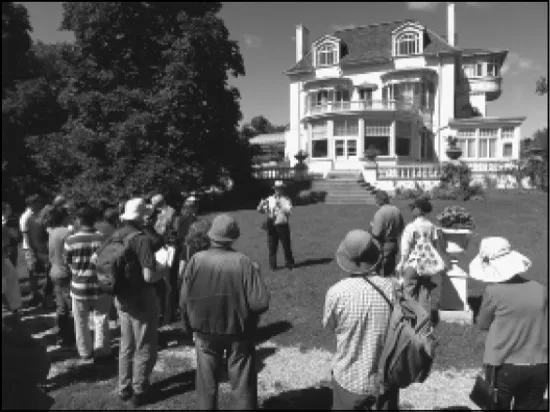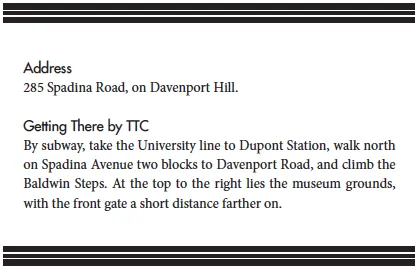
eBook - ePub
Inside the Museum — Spadina House
John Goddard
This is a test
Partager le livre
- 24 pages
- English
- ePUB (adapté aux mobiles)
- Disponible sur iOS et Android
eBook - ePub
Inside the Museum — Spadina House
John Goddard
Détails du livre
Aperçu du livre
Table des matières
Citations
À propos de ce livre
Inside the Museums views Toronto's heritage museums for the first time as a single community — linked by events, personalities, and function. In this special excerpt we visit Spadina House on Davenport Hill, less renowned than its ornate but much later neighbour, Casa Loma, and first erected by landowner and politician Dr. William Baldwin in 1818. John Goddard takes us on a detailed tour, providing fascinating historical background and insight.
Foire aux questions
Comment puis-je résilier mon abonnement ?
Il vous suffit de vous rendre dans la section compte dans paramètres et de cliquer sur « Résilier l’abonnement ». C’est aussi simple que cela ! Une fois que vous aurez résilié votre abonnement, il restera actif pour le reste de la période pour laquelle vous avez payé. Découvrez-en plus ici.
Puis-je / comment puis-je télécharger des livres ?
Pour le moment, tous nos livres en format ePub adaptés aux mobiles peuvent être téléchargés via l’application. La plupart de nos PDF sont également disponibles en téléchargement et les autres seront téléchargeables très prochainement. Découvrez-en plus ici.
Quelle est la différence entre les formules tarifaires ?
Les deux abonnements vous donnent un accès complet à la bibliothèque et à toutes les fonctionnalités de Perlego. Les seules différences sont les tarifs ainsi que la période d’abonnement : avec l’abonnement annuel, vous économiserez environ 30 % par rapport à 12 mois d’abonnement mensuel.
Qu’est-ce que Perlego ?
Nous sommes un service d’abonnement à des ouvrages universitaires en ligne, où vous pouvez accéder à toute une bibliothèque pour un prix inférieur à celui d’un seul livre par mois. Avec plus d’un million de livres sur plus de 1 000 sujets, nous avons ce qu’il vous faut ! Découvrez-en plus ici.
Prenez-vous en charge la synthèse vocale ?
Recherchez le symbole Écouter sur votre prochain livre pour voir si vous pouvez l’écouter. L’outil Écouter lit le texte à haute voix pour vous, en surlignant le passage qui est en cours de lecture. Vous pouvez le mettre sur pause, l’accélérer ou le ralentir. Découvrez-en plus ici.
Est-ce que Inside the Museum — Spadina House est un PDF/ePUB en ligne ?
Oui, vous pouvez accéder à Inside the Museum — Spadina House par John Goddard en format PDF et/ou ePUB ainsi qu’à d’autres livres populaires dans History et North American History. Nous disposons de plus d’un million d’ouvrages à découvrir dans notre catalogue.
Informations
Sujet
HistorySous-sujet
North American HistorySpadina House

Program officer Douglas Fyfe delivers a talk on the south lawn of Spadina House, at the start of a neighbourhood walking tour in the summer of 2013. In the semi-circular “palm room” at the top of the steps, Albert Austin cultivated tropical plants year-round.
Photo by John Goddard
Photo by John Goddard

Fathers and Sons
An unhappy father-son theme runs through the history of Spadina House, a former country mansion overlooking the city from Davenport Hill. The patriarch who built the original house moulded his son to follow in his footsteps, to the substantial benefit of the nation, but at a staggering personal cost to the son. The father who took over the property similarly shaped his son in his own image, with poignant if less dramatic results.
The first pair was William Warren Baldwin and his son Robert, who together articulated and advanced the cause for responsible government in Canada, helping to lay the groundwork for Confederation. The second was James Austin and his son Albert, successive bank- and gas-company presidents. In both families, the third generation crumbled, their broken male heirs unable to sustain a dynasty.
Dr. William Warren Baldwin (1775–1844)
The story begins with William Baldwin. He was a resourceful Irish immigrant and medical graduate from the University of Edinburgh who arrived at York in 1802. The Upper Canadian capital was tiny then. Finding the population too small to support a medical practice, he switched to law. He learned the profession from a borrowed legal textbook, and was called to the bar in 1803. That same year, William married Phoebe Willcocks, daughter of one of his benefactors, and moved into a house at the northwest corner of Front and Frederick Streets. The building would later become famous as William Lyon Mackenzie’s residence and printing shop, target of the 1826 Types Riot. In May 1804, however, it gained distinction as the birthplace of William and Phoebe’s first child, Robert.
William prospered in York. He built a comfortable law practice, became treasurer of the Law Society of Upper Canada, acquired large tracts of land, partly through inheritances, and became a wealthy and socially prominent member of society. He was also a sometime architect, credited with designing the Bank of Upper Canada and parts of Osgoode Hall. “An urbane, polished gentleman, tough-minded and possessed of a high self-regard,” writes historian Robert L. Fraser in the Dictionary of Canadian Biography.
In 1813 William’s father-in-law left him a two-hundred-acre rural lot that included Davenport Hill. The parcel stretched from what is now Bloor Street north to what is now St. Clair Avenue. Other successful families were building grand homes at the time, replacing some of the ramshackle housing of earlier settlement days. In 1817 D’Arcy Boulton Jr. built one of York’s first brick houses, The Grange. The following year, the powerful cleric John Strachan constructed a magnificent brick home called “The Palace,” since demolished, at the northwest corner of what is now Front Street and University Avenue. In 1822 Judge William Campbell commissioned his Georgian brick mansion on what is now Adelaide Street East, in York proper. And in 1818, on Davenport Hill, more than four kilometres from the town centre, William Baldwin designed and erected a handsome two-storey wood-frame house to be used mainly as his country estate. He called it “Spadina,” from a local Native word meaning “hill,” and pronounced “Spa-DEEN-uh,” rather than “Spa-DEYE-nuh,” which is how people now pronounce Spadina Avenue and Spadina subway station.
Below the hill, he also began subdividing property that he owned between Bloor and Queen Streets. He laid out Spadina Avenue as a wide, tree-lined boulevard, with an ornamental garden crescent above College Street where Old Knox College now stands. Neighbouring streets he named after family members, such as Robert, Phoebe, Willcocks, and Baldwin.
In 1820 William entered politics. Although he ranked among the privileged few, he held a skeptical view of the governing clique, the powerful Family Compact, led by the cleric Strachan and lawyer John Beverley Robinson, top advisors to the lieutenant-governor. William won a seat in the elected Legislative Assembly as an opposition member, and began to articulate a Moderate Reform position. The constitution, he argued, gave the province’s elected representatives the right, which they were being denied, “to make laws for their peace, welfare and good government.”
William was no radical. He saw a need for a gentlemen’s class, a type of landed gentry such as himself, loyal to the British Crown. At the same time, he saw virtue in democratic reforms, which, while reserving certain powers for the King and British Parliament, would make the colonial government more accountable, or “responsible,” to electors.
His opposition to government sharpened as he detected lax standards among the elite toward the administration of justice. In 1826 he criticized Robinson, by then attorney general, for failing to reprimand two of his law clerks who had helped destroy Mackenzie’s presses in the Types Riot. Two years later William leapt to the defence of Justice John Willis, fired for alleging that the court was acting unconstitutionally. With his actions, William put himself at the forefront of a Reform coalition. He also brought credibility to Reform. Lieutenant-Governor Sir Peregrine Maitland called him the only Reformer who could also be called a “gentleman.”
In 1829 William’s stand against the Family Compact hardened further. In private correspondence he referred to Strachan, Robinson, Robinson’s brother Peter, Henry John Boulton, and James Buchanan Macaulay as “evil.” He proposed specific reforms. He conceived of what he called “a provincial ministry,” or cabinet, responsible to an elected “provincial parliament,” and ultimately to its electors. Such reform, he said, must be lawful and constitutional — armed rebellion was out of the question — principles that helped lay the basis for the ultimately successful push for “responsible government.”
Robert Baldwin (1804–1858)
“I intend please God to bring him up to the bar,” William wrote of his eldest son, Robert, when the child was fourteen. Robert’s destiny was sealed. There would be two other sons in the family, after two died in childhood, and no girls, but to their father the most important son remained the first-born, to whom William would leave his entire inheritance, and into whom he poured all his expectations for success and respectability.
“[William Baldwin’s] purpose was...